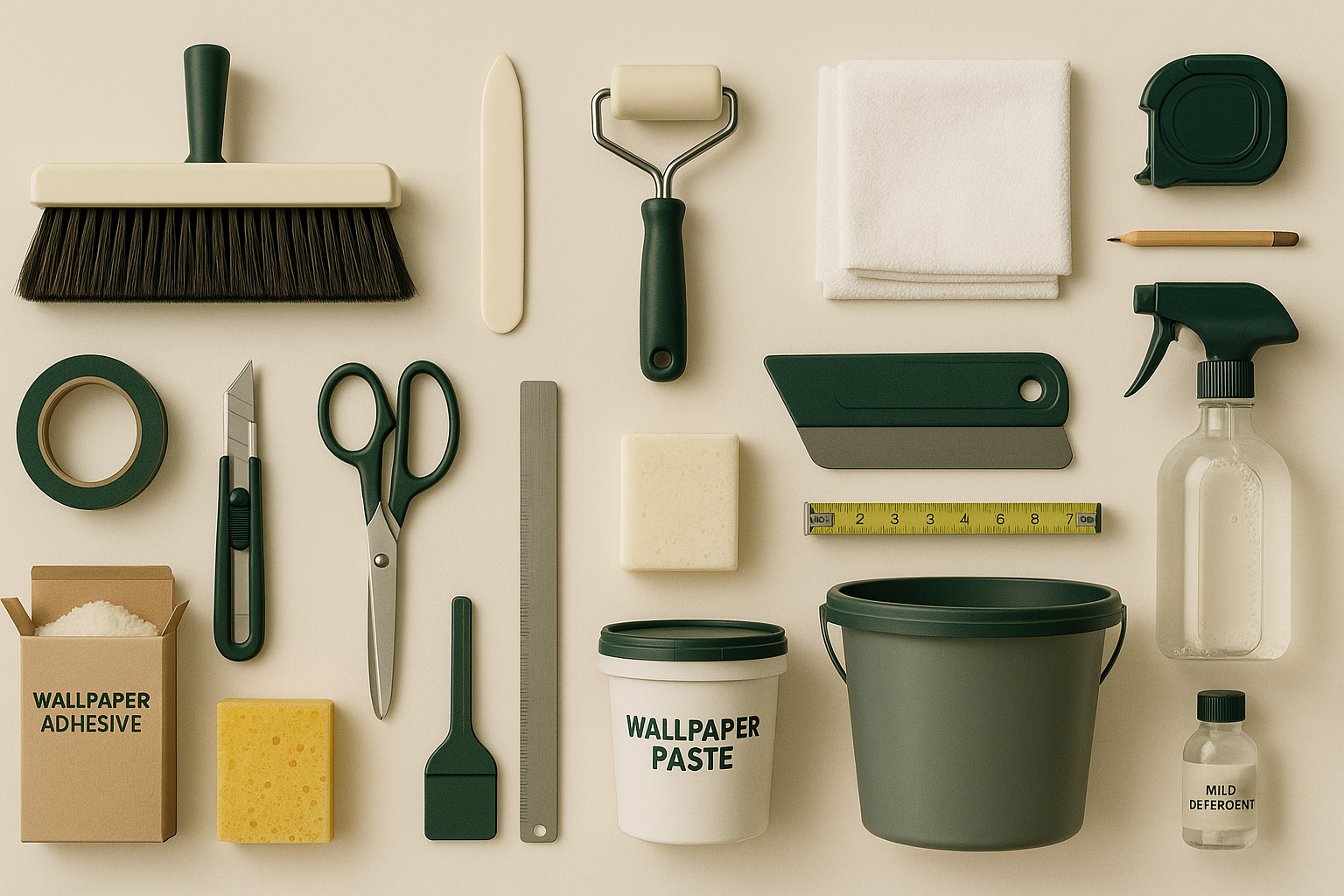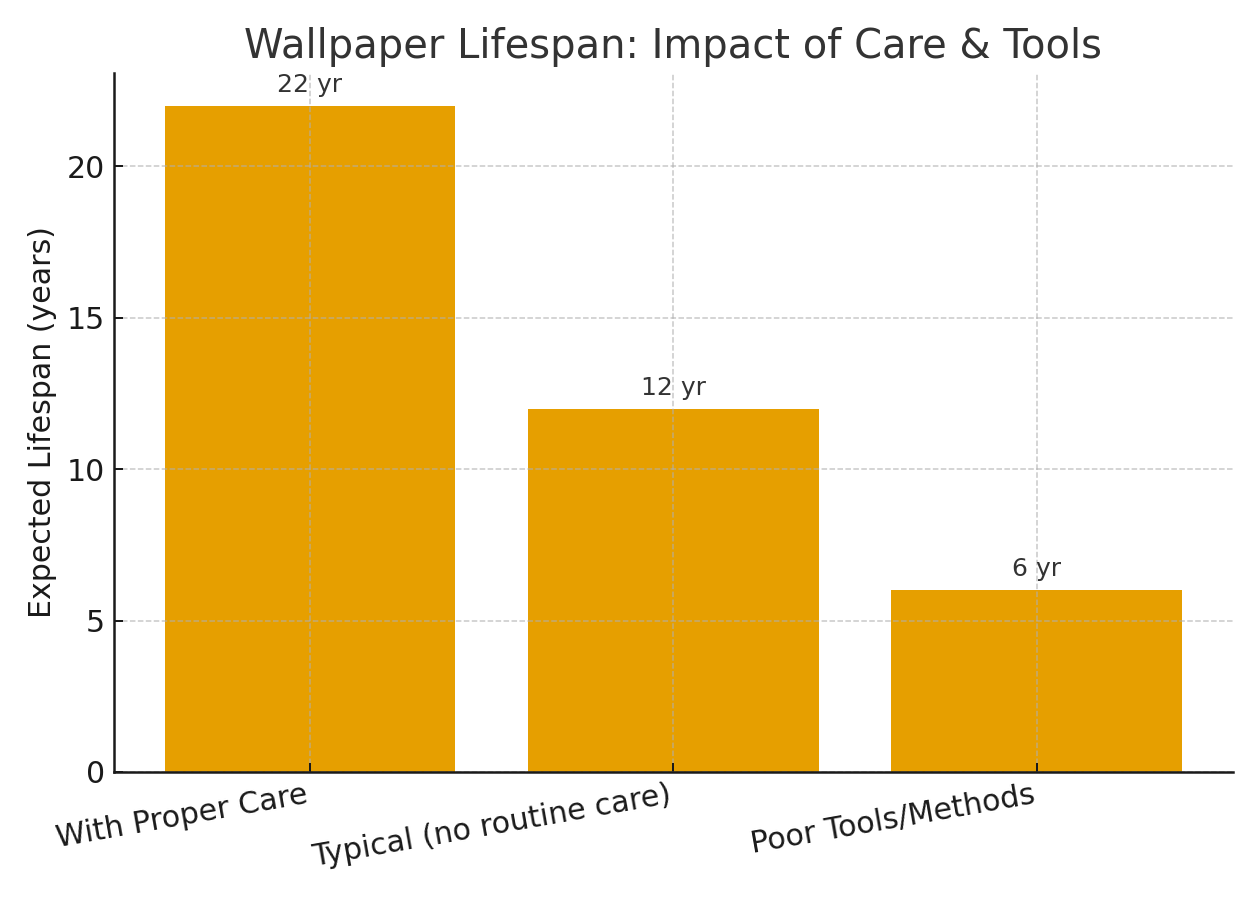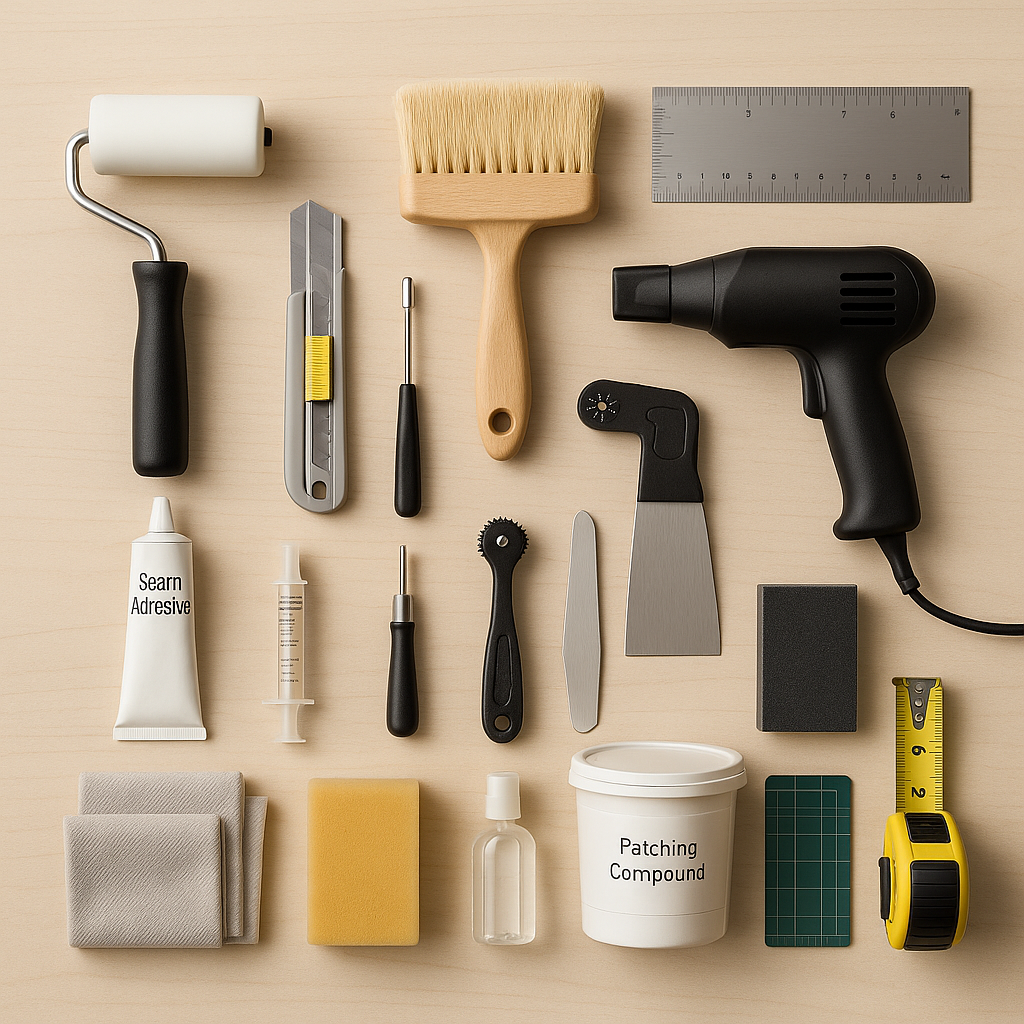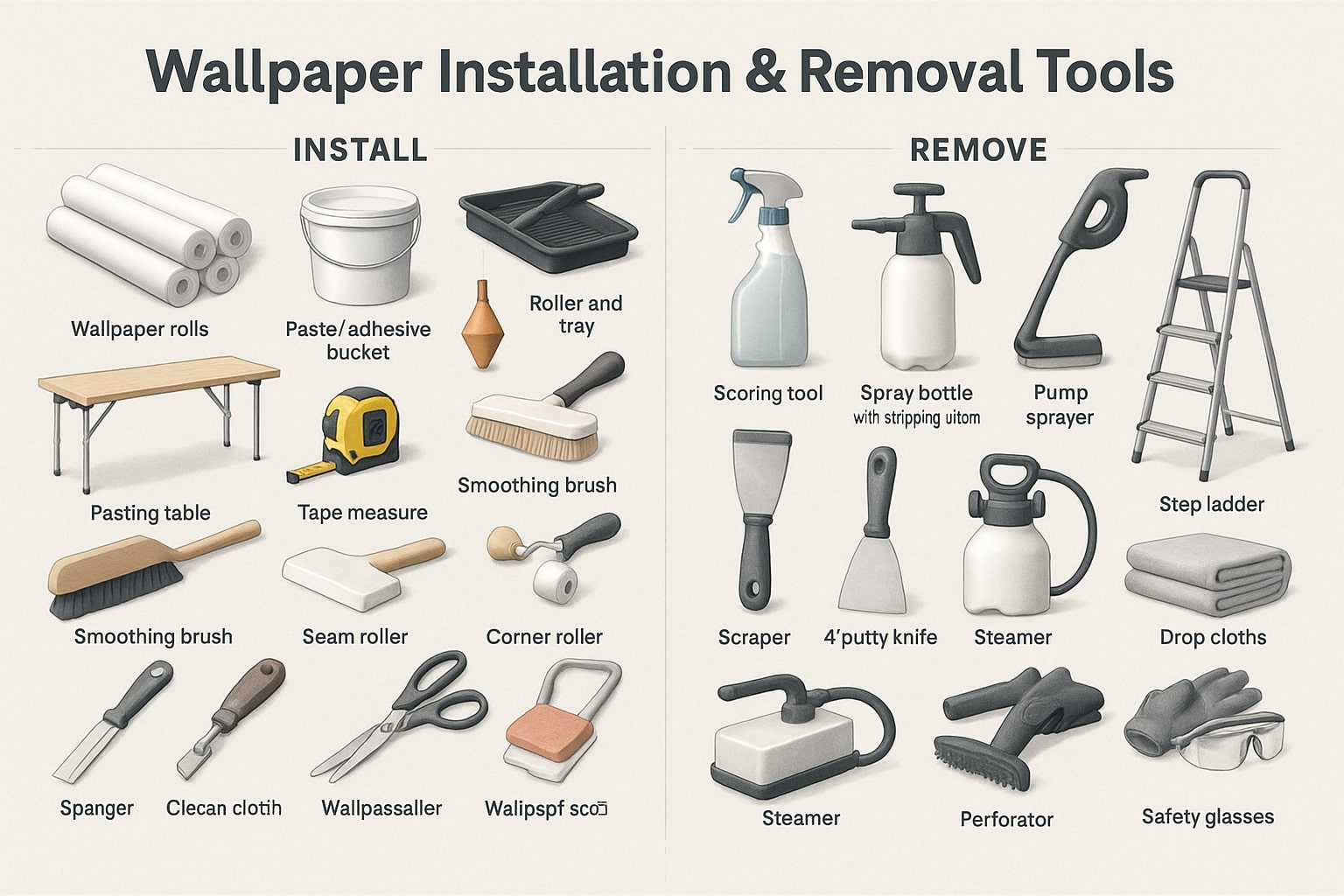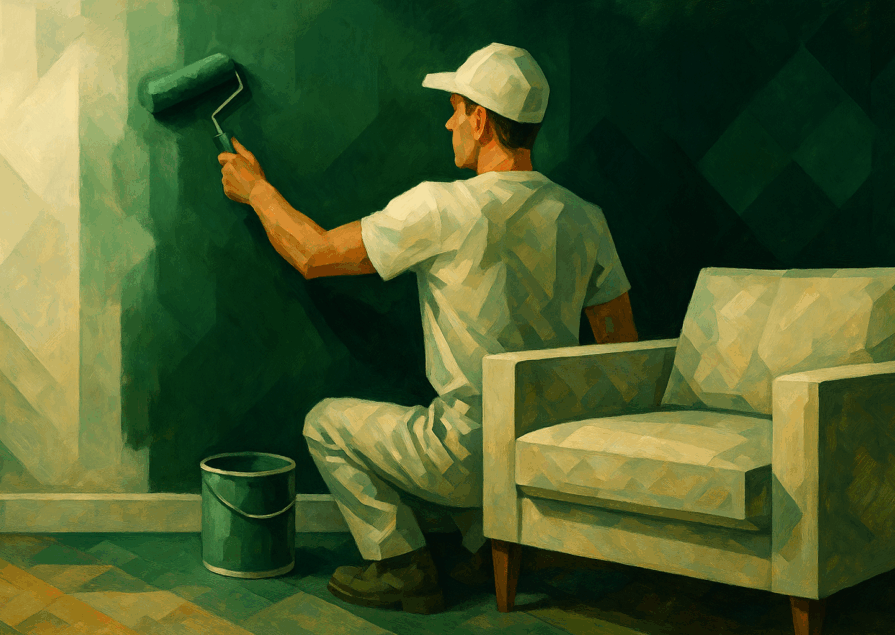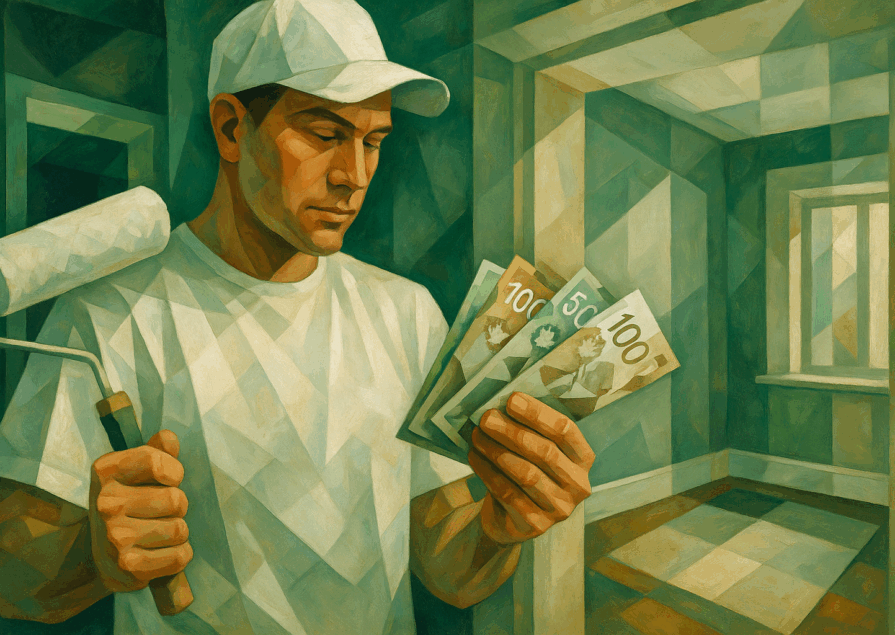Essential Tools for Wallpaper Care: Complete Guide for Homeowners
Wallpaper can transform any room into a stunning visual statement, but maintaining its beauty requires the right tools and knowledge. Whether you’re dealing with vintage vinyl, delicate grasscloth, or modern peel-and-stick varieties, having essential wallpaper care tools on hand can extend your wallpaper’s lifespan from the typical 10-15 years to well over two decades with proper maintenance.
The key to successful wallpaper care lies not just in knowing what to do, but in having the right equipment to do it safely and effectively. From daily dusting to emergency repairs, each task requires specific tools designed to work with wallpaper’s unique characteristics. This comprehensive guide will walk you through every tool you need, when to use them, and how to build a complete wallpaper care arsenal that protects your investment.
Why Proper Wallpaper Care Tools Matter
The difference between well-maintained wallpaper and neglected surfaces is dramatic. Wallpaper that receives regular care with appropriate tools can maintain its original appearance and adhesion for decades, while improper maintenance can lead to premature fading, peeling, and damage that requires costly replacement.
Professional wallpaper installers report that homeowners who invest in proper care tools see significantly fewer issues with seam separation, surface damage, and color degradation. The initial investment in quality tools typically pays for itself within the first year by preventing repair costs and extending replacement intervals.
Most wallpaper damage occurs not from age, but from improper cleaning techniques and inadequate tools. Using household cleaning products not designed for wallpaper, applying excessive moisture, or scrubbing with abrasive materials can cause irreversible harm. The right tools eliminate these risks while making maintenance tasks more efficient and effective.
Essential Wallpaper Cleaning Tools
Daily Maintenance Tools
The foundation of wallpaper care begins with daily maintenance tools that remove dust, prevent buildup, and catch potential issues early. Microfiber cloths represent the gold standard for wallpaper cleaning, but not all microfiber is created equal. Look for cloths with a GSM (grams per square meter) rating between 300-400, which provides optimal cleaning power without excessive friction that could damage delicate surfaces.
Soft-bristled brushes serve as your primary tool for textured wallpaper maintenance. Natural bristle brushes work best for grasscloth and fabric wallpapers, while synthetic bristles excel with vinyl and washable varieties. The ideal brush features bristles no longer than half an inch, preventing excessive pressure while allowing thorough dust removal from textured surfaces.
Vacuum attachments designed specifically for delicate surfaces complete your daily arsenal. The brush attachment should feature soft, natural bristles and variable suction control. Many homeowners make the mistake of using standard vacuum attachments, which can create enough suction to pull wallpaper away from walls or damage surface textures.
| Tool | Primary Use | Best For | Avoid On | Notes |
| Microfiber cloth (300–400 GSM) | Daily dusting / light wipe | All wallpapers (dry or barely damp) | Heavy soil / stains | Low friction; do not oversaturate. |
| Soft-bristled brush (natural) | Dust removal on textured surfaces | Grasscloth, fabric, natural fibers | High-gloss vinyl (may leave faint marks) | Short bristles (≤ 0.5 in) prevent excess pressure. |
| Soft-bristled brush (synthetic) | Routine dusting / agitation before vacuuming | Vinyl & washable wallpapers | Delicate silks / hand-painted papers | Consistent bristle stiffness; gentle pressure only. |
| Vacuum brush (soft natural bristles, variable suction) | Dust removal with suction control | All textured wallpapers | Loose/lifting edges (reduce suction) | Use lowest effective suction and keep head moving. |
| Lint roller | Pick up lint/pet hair | Fabric/textile wallpapers | Paper-backed wallpapers (may pull fibers) | Use light pressure; test first. |
Deep Cleaning Equipment
When daily maintenance isn’t sufficient, deep cleaning equipment becomes essential. Steam cleaners designed for wallpaper use operate at lower temperatures and pressures than standard models, typically producing steam at 200-220°F rather than the 300°F+ of traditional steam cleaners. This temperature range effectively sanitizes and refreshes washable wallpaper without risking adhesive failure.
Specialized wallpaper cleaning solutions differ significantly from general-purpose cleaners. These formulations account for wallpaper’s porous nature and potential color sensitivity. Quality wallpaper cleaners maintain a pH between 6.5-7.5, preventing the alkaline damage that can occur with standard household cleaners.
pH-neutral cleaners represent the safest option for sensitive materials like silk wallpaper or hand-painted varieties. These cleaners remove dirt and stains without altering the chemical composition of natural fibers or affecting color stability. When selecting cleaners, always verify compatibility with your specific wallpaper type through manufacturer recommendations.
Stain Removal Tools
Effective stain removal requires targeted tools for different stain types. Spot cleaning kits designed for wallpaper typically include multiple solution types, applicator brushes, and blotting materials. These kits address common household stains like food spills, crayon marks, and fingerprints without spreading the stain or damaging surrounding areas.
Grease-cutting solutions formulated for wallpaper use enzymes rather than harsh detergents to break down oily stains. These solutions work more slowly than kitchen degreasers but prevent the surface damage and discoloration that aggressive cleaners can cause on wallpaper.
Ink and marker removal requires specialized solvents that dissolve ink without affecting wallpaper dyes or coatings. Alcohol-based removers work effectively on most ink types, but always test in an inconspicuous area first. Some wallpapers, particularly those with metallic elements, can be permanently damaged by alcohol-based products.
Wallpaper Repair and Restoration Tools
Basic Repair Kit Essentials
Every homeowner with wallpaper should maintain a basic repair kit containing wallpaper adhesive, seam rollers, and precision cutting tools. Wallpaper adhesive comes in several formulations, with vinyl adhesive for vinyl wallpapers, clay-based adhesive for traditional papers, and specialized formulations for specific materials like grasscloth or fabric.
Seam rollers serve multiple purposes beyond initial installation. These tools prove invaluable for addressing lifted edges, smoothing bubbles, and ensuring proper adhesion during repairs. Professional-quality seam rollers feature slightly rounded edges that prevent cutting or tearing while applying consistent pressure across seam lines.
Precision cutting tools include sharp utility knives with fresh blades, metal straightedges, and fine-point scissors. Dull blades can tear wallpaper rather than cutting cleanly, creating ragged edges that make repairs more visible. Replace utility knife blades frequently, as wallpaper dulls blades more quickly than other materials.
Advanced Repair Equipment
Professional-grade steamers for bubble removal operate at precisely controlled temperatures and steam output levels. These units allow for targeted application of steam to specific areas without oversaturating surrounding wallpaper. The controlled approach prevents adhesive failure in adjacent areas while effectively addressing localized issues.
Injection needles provide the most precise method for applying adhesive to specific problem areas. These tools allow you to inject adhesive directly behind lifted sections or bubbles without removing wallpaper sections. Medical-grade syringes with blunt-tip needles work well for this application, providing precise control over adhesive placement and quantity.
Texture matching tools become essential when dealing with heavily textured wallpapers. These specialized rollers and brushes recreate surface patterns during repairs, making patches virtually invisible. Professional installers often create custom texture tools using common materials like sea sponges or carved rollers to match specific patterns.
Installation and Removal Tools
Hanging Tools for Touch-ups
While full installation requires comprehensive tools, touch-up work needs specific hanging tools for small sections and repairs. Plumb lines and small levels ensure proper alignment when replacing sections or adding new strips. Digital levels with magnetic bases provide the most accurate readings and attach securely to metal straightedges.
Smoothing brushes designed for wallpaper installation feature natural bristles that won’t scratch or damage surfaces. These brushes remove air bubbles and ensure complete adhesion without applying excessive pressure that could stretch or tear wallpaper. The ideal smoothing brush measures 6-8 inches wide with bristles approximately one inch long.
Trim guides help achieve professional-looking edges when cutting wallpaper in place. These metal guides protect walls and baseboards while providing a straight cutting edge. Quality trim guides feature rubber backing that prevents slipping and protects wall surfaces from scratches.
Safe Removal Equipment
Wallpaper removal requires specific tools to prevent wall damage during the process. Plastic scrapers prove safer than metal alternatives for most wallpaper types, removing material without gouging drywall or plaster underneath. Metal scrapers should be reserved for particularly stubborn adhesive or heavily painted wallpaper.
Removal solutions and steamers designed for wallpaper elimination work by softening adhesive rather than dissolving it completely. This approach allows for easier removal while minimizing the sticky residue that can complicate wall preparation for new treatments. Fabric softener-based solutions often work as effectively as commercial removers at a fraction of the cost.
Surface protection materials include plastic sheeting, masking tape, and drop cloths designed to protect flooring and furnishings during removal projects. Proper preparation prevents damage to surrounding areas and makes cleanup more manageable.
| Method | Required Tools | Difficulty (1-5) | Residue Risk | Damage Risk | Typical Time per 100 sq ft (min) |
| Steamer | Wallpaper steamer, plastic scraper, drop cloths | 3 | Low | Low–Med | 45 |
| Fabric softener solution + scraper | Diluted fabric softener, spray bottle, plastic scraper | 2 | Med | Low | 60 |
| Commercial remover + scraper | Wallpaper remover solution, spray, plastic scraper | 3 | Low–Med | Low | 55 |
| Dry peel (peel-and-stick) | Hands, plastic scraper for edges | 1 | Low | Low | 30 |
| Scoring + soak + scraper | Scoring tool, soak solution, plastic scraper | 4 | Med–High | Med | 75 |
Specialized Tools by Wallpaper Type
Vinyl Wallpaper Care Tools
Vinyl wallpaper tolerates more aggressive cleaning than other types but still requires specific tools for optimal care. Non-abrasive cleaning solutions formulated for vinyl remove grease and stains without dulling the surface finish. These solutions typically contain mild detergents and anti-static agents that prevent dust attraction.
Anti-static brushes prevent static buildup that attracts dust and pet hair to vinyl surfaces. These brushes feature conductive bristles that dissipate electrical charges while cleaning. Regular use of anti-static brushes significantly reduces the frequency of deep cleaning required.
Scratch repair kits for vinyl wallpaper include color-matched compounds and application tools. These kits address minor surface damage that can occur from furniture contact or general wear. Professional-quality kits include multiple color options and clear protective coatings that restore both appearance and surface protection.
Fabric and Textile Wallpaper Tools
Fabric wallpaper requires gentler tools that respect the material’s delicate nature. Fabric-safe vacuum attachments feature soft bristles and reduced suction settings that remove dust without pulling fibers or causing surface damage. These attachments often include multiple brush types for different fabric textures.
Dry cleaning solvents designed for wallpaper use provide safe stain removal for fabric surfaces that cannot tolerate water-based cleaning. These solvents evaporate quickly without leaving residue and work effectively on oil-based stains that water-based cleaners cannot address.
Lint rollers and specialized brushes help maintain fabric wallpaper’s appearance between professional cleanings. These tools remove surface debris and restore fabric texture without the moisture risks associated with other cleaning methods.
Grasscloth and Natural Material Tools
Natural fiber wallpapers require specialized tools that work with the material’s organic characteristics. Natural fiber brushes complement grasscloth textures while removing dust and debris from the intricate surface patterns. Boar bristle brushes work particularly well for this application.
Humidity control devices help maintain stable environmental conditions that prevent natural materials from expanding, contracting, or developing mold issues. Dehumidifiers and humidifiers with precise controls maintain the 30-50% relative humidity range optimal for natural fiber wallpapers.
Specialized cleaning compounds for natural materials typically use dry-cleaning principles rather than water-based solutions. These compounds absorb dirt and oils without introducing moisture that could damage natural fibers or cause adhesive failure.
Professional-Grade vs. DIY Tools
When to Invest in Professional Equipment
The decision between professional and consumer-grade tools depends on several factors including wallpaper value, maintenance frequency, and skill level. Professional equipment typically offers greater precision, durability, and specialized features that justify higher costs for serious enthusiasts or those maintaining expensive wallpapers.
Cost-benefit analysis favors professional tools when wallpaper value exceeds $5 per square foot or when dealing with large installations over 500 square feet. Professional steamers, for example, cost 3-4 times more than consumer models but provide precise temperature control and consistent performance that prevents costly damage.
Quality and durability factors make professional tools economical for long-term use. Professional-grade tools typically last 5-10 times longer than consumer alternatives and maintain consistent performance throughout their lifespan. This longevity often makes professional tools less expensive per use over time.
| Tool | Consumer Price (USD) | Pro Price (USD) | Consumer Lifespan (yrs) | Pro Lifespan (yrs) |
| Steam cleaner | 80 | 200 | 3 | 8 |
| Vacuum (variable suction + soft brush) | 60 | 180 | 4 | 8 |
| Seam roller (rounded edges) | 15 | 35 | 5 | 10 |
| Adhesive injector (syringe + blunt needle) | 10 | 25 | 3 | 7 |
| Smoothing brush (natural bristle) | 20 | 45 | 4 | 9 |
| Trim guide (rubber-backed metal) | 15 | 40 | 5 | 10 |
Budget-Friendly Alternatives
Multi-purpose tools can address multiple wallpaper care needs while keeping costs manageable. A quality steam cleaner with variable temperature controls can serve for both deep cleaning and repair work. Similarly, a good vacuum with multiple attachments can handle daily maintenance across different wallpaper types.
DIY solution recipes using common household items can substitute for specialized cleaners in many situations. A mixture of warm water, white vinegar, and mild dish soap works effectively for routine vinyl wallpaper cleaning. Fabric softener diluted with water creates an effective wallpaper removal solution at minimal cost.
Tool rental options make professional equipment accessible for occasional use without the full purchase cost. Many home improvement stores rent wallpaper steamers, professional-grade vacuums, and removal tools for weekend projects. Rental costs typically run 10-15% of purchase price per day.
Tool Storage and Organization
Creating a Wallpaper Care Kit
An effective wallpaper care kit includes essential tools for routine maintenance, emergency repairs, and seasonal deep cleaning. Essential tools include microfiber cloths, soft brushes, gentle cleaning solutions, basic adhesive, and a seam roller. Optional tools can be added based on specific wallpaper types and maintenance frequency.
Portable storage solutions keep tools organized and easily accessible. Tool bags designed for cleaning supplies work well for wallpaper care kits, providing separated compartments for liquids, tools, and supplies. Clear containers allow for quick inventory checks and prevent tools from becoming scattered.
Climate-controlled storage protects tools and supplies from temperature and humidity extremes that can affect performance. Adhesives, in particular, can degrade in extreme temperatures or high humidity. A basement or closet with moderate temperatures provides ideal storage conditions for most wallpaper care supplies.
Maintenance Schedules and Tool Usage
Weekly Care Routines
Weekly maintenance prevents small issues from becoming major problems. Quick inspection tools include a flashlight for examining seams and edges, and a magnifying glass for detailed surface assessment. These simple tools help identify lifting edges, developing stains, or other issues while they remain easily addressable.
Light cleaning equipment for weekly use includes microfiber cloths and soft brushes for dust removal. Establishing a routine of weekly dusting prevents buildup that requires more aggressive cleaning methods. Focus on high-traffic areas, areas near heating vents, and zones where cooking vapors or other contaminants might accumulate.
Preventive maintenance items include seam rollers for addressing minor lifting and spot cleaning supplies for immediate stain treatment. Addressing small issues immediately prevents them from spreading or requiring more extensive repairs later.
Seasonal Deep Care
Quarterly deep cleaning requires more comprehensive tools including steam cleaners, specialized cleaning solutions, and detailed inspection equipment. This deeper maintenance addresses accumulated soil, refreshes surface appearance, and identifies any developing issues that need professional attention.
Annual inspection equipment includes moisture meters for detecting potential adhesive issues, infrared thermometers for identifying temperature variations that might affect wallpaper, and detailed documentation tools for tracking condition changes over time.
Long-term preservation supplies include protective treatments for high-wear areas, specialized storage for spare wallpaper pieces, and documentation of installation details and maintenance history. This information proves valuable for future repairs or replacement planning.
| Frequency | Tasks | Recommended Tools |
| Weekly | Dust high-traffic areas; quick seam & edge inspection | Microfiber cloth (300–400 GSM), soft brush, flashlight |
| Monthly | Full-room dusting; spot clean minor marks | Vacuum (soft brush, low suction), microfiber, pH-neutral cleaner |
| Quarterly | Deep clean washable areas; address minor lifts/bubbles | Low-temp steamer, pH-neutral cleaner, seam roller, adhesive syringe |
| Annually | Comprehensive inspection & documentation; humidity check | Moisture meter, hygrometer/humidifier or dehumidifier, camera/app for notes |
Common Mistakes and Tool Misuse
Damaging Cleaning Techniques
Many homeowners unknowingly damage their wallpaper by using inappropriate tools or techniques. Excessive moisture represents the most common error, often resulting from using steam cleaners at too high temperatures or applying water-based cleaners to non-washable wallpapers. Always verify cleaning method compatibility before proceeding.
Pressure and technique mistakes include scrubbing with excessive force, using stiff brushes on delicate surfaces, and applying concentrated cleaning solutions without proper dilution. Wallpaper responds better to gentle, repeated cleaning than aggressive single treatments. Patience and proper technique preserve surface integrity while achieving better cleaning results.
Chemical compatibility issues arise when mixing different cleaning products or using inappropriate cleaners for specific wallpaper types. Bleach-based cleaners can permanently discolor wallpaper, while ammonia-based products can damage adhesives. Always use products specifically designed for wallpaper cleaning.
Improper Tool Selection
Matching tools to wallpaper materials requires understanding both the surface characteristics and underlying substrate. Vinyl wallpaper tolerates different cleaning methods than paper-backed varieties, while fabric wallpapers need completely different approaches. Mismatched tools can cause permanent damage that requires section replacement.
Understanding tool limitations prevents overuse that can damage wallpaper or create safety hazards. Steam cleaners, for example, should never be used on wallpapers with metallic elements that can conduct heat. Similarly, alcohol-based cleaners can dissolve certain adhesives or cause color bleeding in sensitive inks.
Safety considerations include proper ventilation when using chemical cleaners, electrical safety with steam equipment, and ladder safety for reaching high areas. Never assume that wallpaper-safe products are completely harmless; always follow manufacturer instructions and maintain adequate ventilation.
Where to Buy Wallpaper Care Tools
Online Retailers and Specialty Stores
Major online retailers offer convenience and competitive pricing for common wallpaper care tools. However, specialized wallpaper suppliers often carry higher-quality tools and provide expert guidance for specific applications. Professional wallpaper retailers typically stock commercial-grade tools not available through general retailers.
Trusted brand recommendations include Zinsser for cleaning solutions, Wagner for steam equipment, and Hyde for hand tools. These manufacturers specialize in wallpaper-related products and offer superior performance compared to generic alternatives. Their products often include specific instructions for wallpaper applications.
Price comparison strategies should consider total cost including shipping, return policies, and warranty coverage. The cheapest initial price often proves more expensive when factoring in replacement costs or shipping charges. Local specialty stores may offer competitive pricing when these factors are considered.
Professional Supply Sources
Trade-only suppliers offer access to professional-grade tools and bulk purchasing options. Many of these suppliers will sell to serious DIY enthusiasts, particularly for larger purchases. Professional tools often come with extended warranties and technical support not available with consumer products.
Bulk purchasing options reduce per-unit costs for supplies like cleaning solutions, adhesives, and replacement parts. This approach works well for property managers or homeowners with extensive wallpaper installations. Bulk purchases also ensure supply availability for future maintenance needs.
Professional consultation services help match tools to specific applications and provide training on proper usage. Many professional suppliers offer this service free with tool purchases, providing valuable expertise that prevents costly mistakes.
Cost Analysis: Building Your Tool Collection
Starter Kit Budget (CAD 55–90)
A basic wallpaper care kit within this budget includes essential tools for routine maintenance and minor repairs. Core items now updated with current CAD estimates:
-
Quality microfiber cloths: CAD 15
-
Soft-bristled brushes: CAD 20
-
Wallpaper-safe cleaning solution: CAD 8–23 (depending on size and brand)
-
Basic adhesive (quart of ROMAN PRO-880): CAD 25–28
-
Seam roller: CAD 8–10
-
Storage container: CAD 10–15
This brings the starter kit into a total cost of roughly CAD 60–95—right within the original target range.
Multi-Purpose Options
-
Handheld/multi-purpose steam cleaner: CAD 45–100 for general-purpose models. (Note: dedicated wallpaper steamers are more expensive.)
-
Vacuum with brush attachments: Typically CAD 100–200 for a reliable upright model—higher than the USD-based estimate of $40–60.
Complete Professional Setup (CAD 300–500)
For a comprehensive professional kit:
-
Dedicated wallpaper steamer: CAD 150–200, e.g., Wagner steamer models.
-
Advanced cleaning solution sets: CAD 20–30
-
Precision repair tools (trowels, detail brushes, etc.): CAD 75–100
-
Storage system: CAD 50–75
Totaling approximately CAD 295–405, which fits well within the stated range of CAD 300–500.
Expert Tips for Tool Longevity
Proper Tool Maintenance
Tool longevity depends significantly on proper cleaning and storage after each use. Steam cleaners require thorough flushing with clean water after use to prevent mineral buildup that can damage internal components. Cleaning solutions should be wiped from tool surfaces to prevent residue accumulation that can affect performance.
Storage requirements vary by tool type but generally favor cool, dry conditions with moderate temperatures. Extreme temperature variations can damage seals, affect adhesive properties, and cause metal corrosion. Dedicated storage areas maintain tools in ready-to-use condition while extending their useful life.
Replacement schedules help maintain optimal tool performance. Brush bristles should be replaced when they begin to splay or become stiff. Vacuum filters need regular replacement to maintain suction efficiency. Cleaning solution effectiveness diminishes over time, particularly after containers have been opened and exposed to air.
Maximizing Tool Performance
Technique optimization involves understanding each tool’s optimal usage patterns and limitations. Steam cleaners perform best when allowed to reach full operating temperature before use. Brushes work more effectively with light, consistent pressure rather than aggressive scrubbing motions.
Tool combination strategies leverage the strengths of different tools for complex tasks. Pre-treating stains with appropriate solutions before steam cleaning improves results while reducing the aggressive cleaning required. Similarly, using appropriate brushes before vacuuming removes more debris with less effort.
Efficiency improvements come from organizing tools and supplies for easy access and developing systematic approaches to maintenance tasks. Having all necessary tools readily available reduces task time while ensuring thorough completion. Systematic approaches ensure consistent results and prevent missed areas that could develop into larger problems.
Conclusion
Proper wallpaper care requires the right tools, but the investment pays significant dividends in extended wallpaper life, maintained appearance, and reduced replacement costs. Starting with essential cleaning and maintenance tools provides immediate benefits, while gradually building a comprehensive tool collection enables increasingly sophisticated care and repair capabilities.
The key to successful wallpaper maintenance lies in matching tools to specific wallpaper types and understanding proper usage techniques. Quality tools, used correctly, prevent damage while maintaining wallpaper’s original beauty for decades. Whether you choose basic consumer tools or invest in professional-grade equipment, having the right tools available when needed makes the difference between minor maintenance and major replacement projects.
Remember that wallpaper care is an ongoing process rather than occasional deep cleaning. Regular maintenance with appropriate tools prevents most problems while keeping your walls looking their best. The time and money invested in proper tools and techniques preserve your wallpaper investment while maintaining the beauty that drew you to wallpaper in the first place.
Frequently Asked Questions
Can I use regular household cleaning tools on all types of wallpaper?
No, regular household cleaning tools can damage many wallpaper types. Standard vacuum attachments may have too much suction, regular cleaning cloths can be too abrasive, and household cleaners often contain chemicals that can discolor or damage wallpaper adhesives. Always use tools specifically designed for wallpaper care.
How often should I replace my wallpaper care tools?
Replacement frequency depends on usage and tool quality. Microfiber cloths should be replaced every 6-12 months with regular use, brush bristles when they become splayed or stiff, and cleaning solutions when they expire or lose effectiveness. Professional-grade tools typically last 5-10 years with proper maintenance.
Are expensive wallpaper care tools worth the investment for occasional use?
For occasional use, mid-range tools often provide the best value. However, if your wallpaper is valuable or covers large areas, professional tools can prevent costly damage. Consider tool rental for expensive items used infrequently, and focus your investment on tools used most often like cloths, brushes, and basic cleaning solutions.
What’s the most common mistake people make when choosing wallpaper care tools?
The most common mistake is assuming all wallpaper can be treated the same way. Using vinyl wallpaper tools on fabric wallpaper, or applying steam to heat-sensitive materials can cause permanent damage. Always identify your wallpaper type first, then select appropriate tools and techniques.
Can I rent professional wallpaper care equipment instead of buying?
Yes, many home improvement stores rent professional wallpaper steamers, commercial-grade vacuums, and specialized removal tools. Rental makes sense for one-time projects or when trying equipment before purchasing. However, for ongoing maintenance, purchasing basic tools proves more economical and ensures availability when needed.
